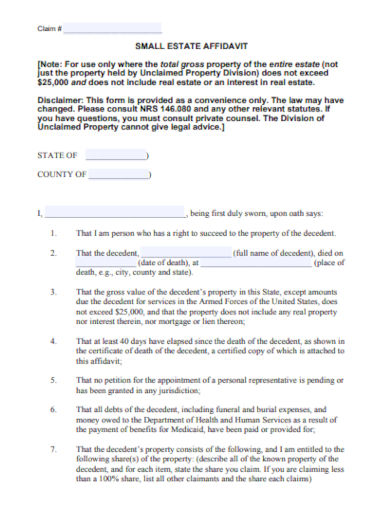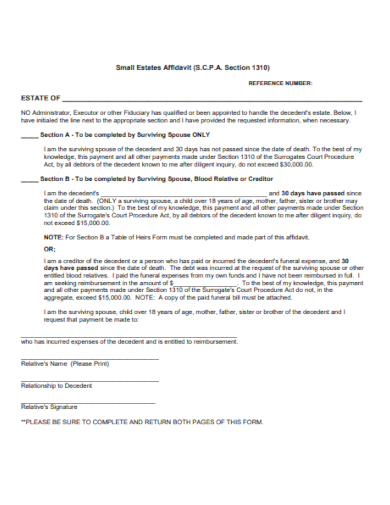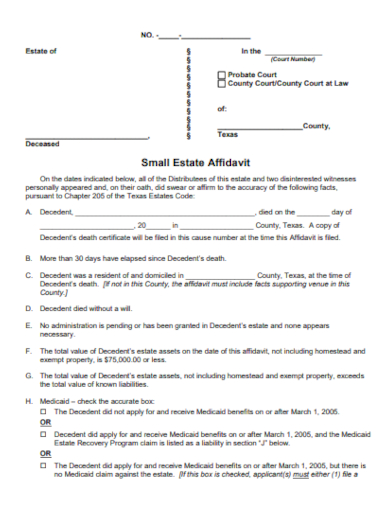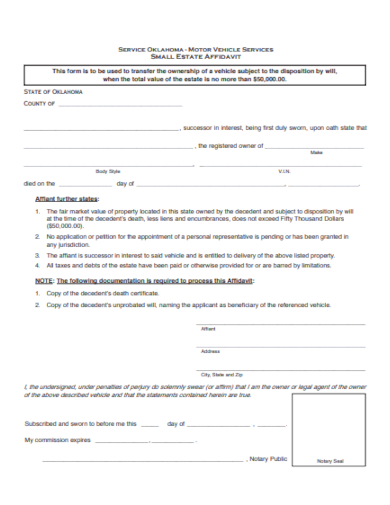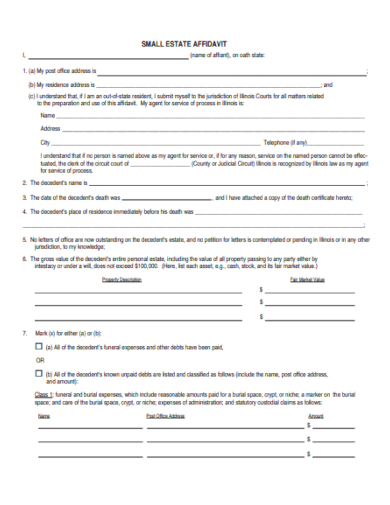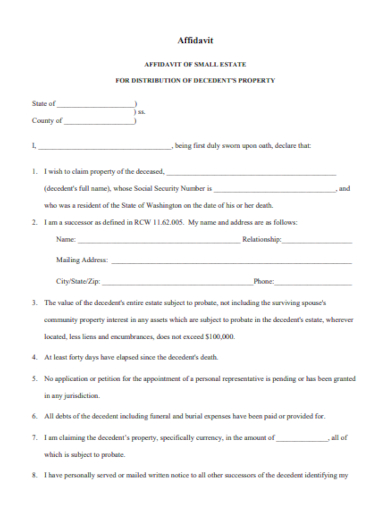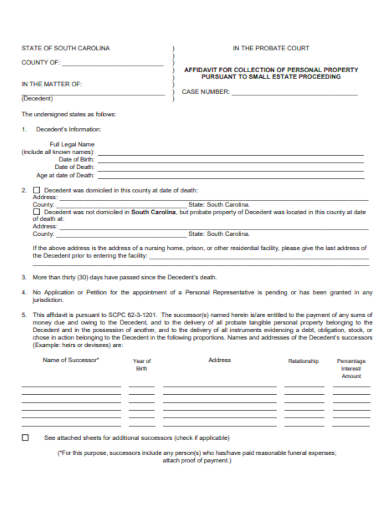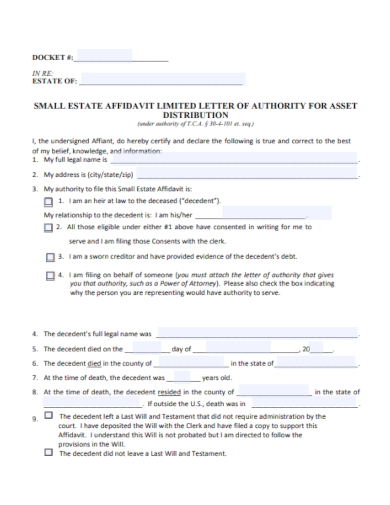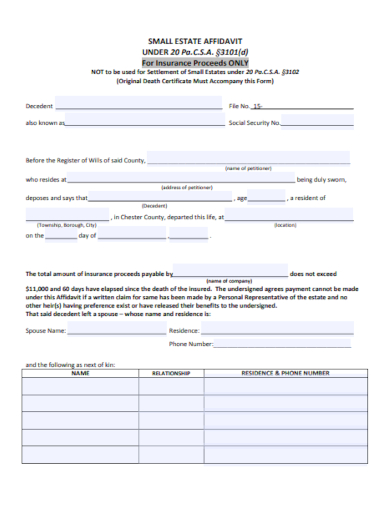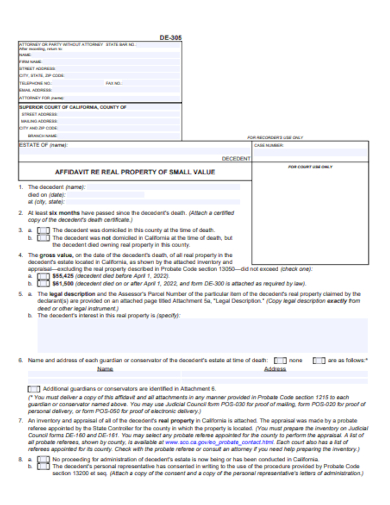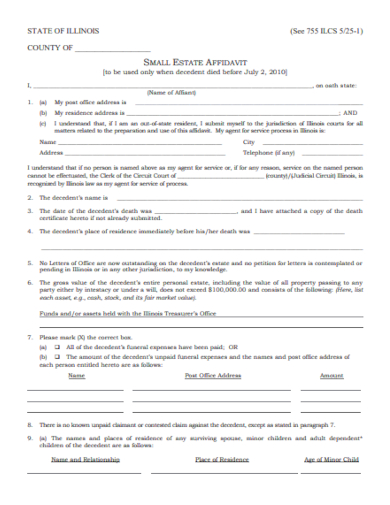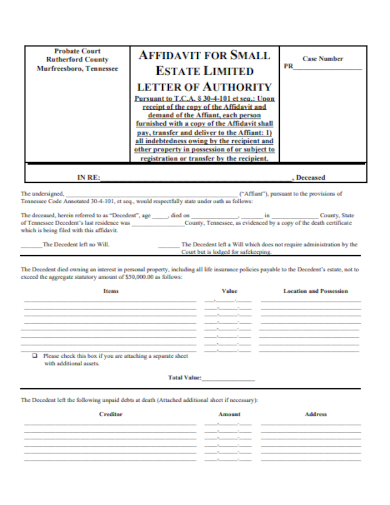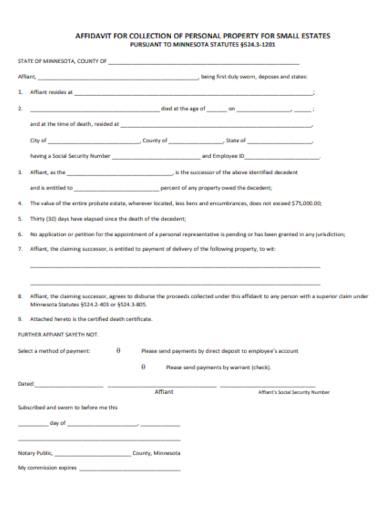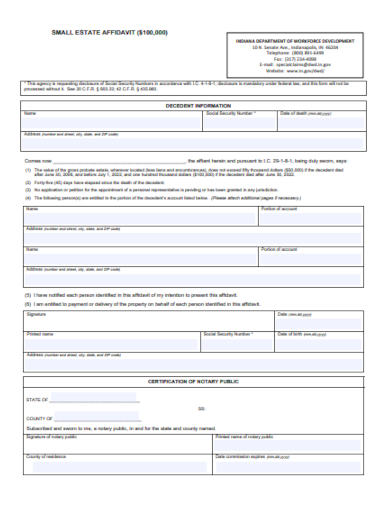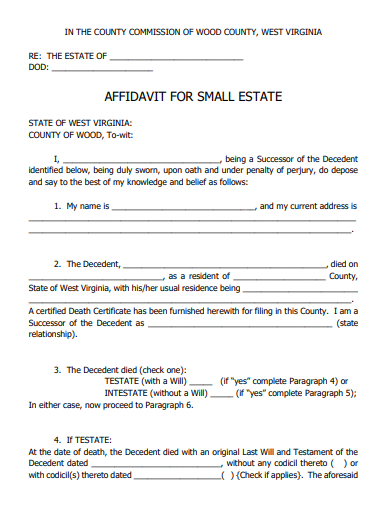Estate management, particularly for smaller inheritances, can be a labyrinth of complexities. Our Small Estate Affidavit Template serves as a trusted compass, guiding you through each step with precision. Built on a foundation of legal expertise, this guide is an essential companion for individuals eager to simplify their inheritance proceedings. Delve into our expertly curated resource and experience the fusion of compliance and confidence. Embrace the ease of seamless estate management.
20+ Small Estate Affidavit Samples
1. Printable Small Estate Affidavit Template
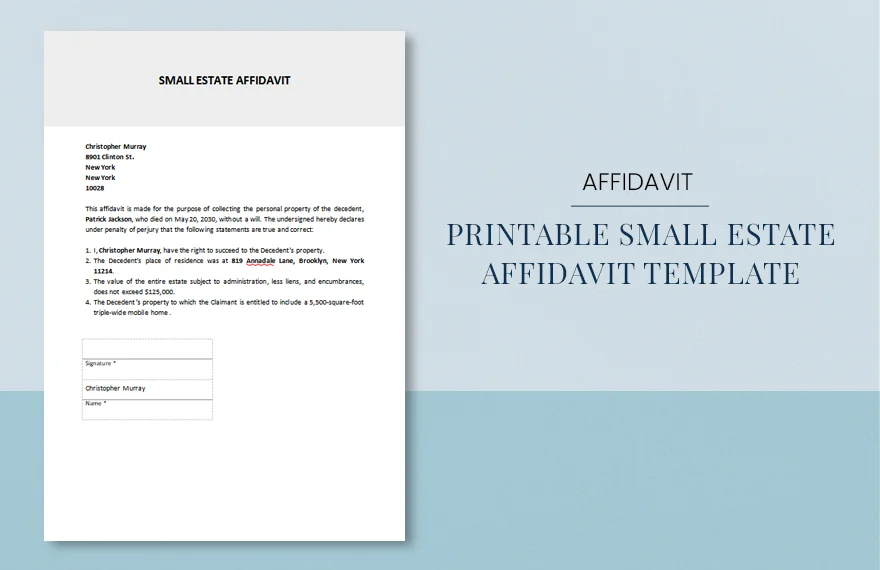
2. Small Estate Affidavit Form Template
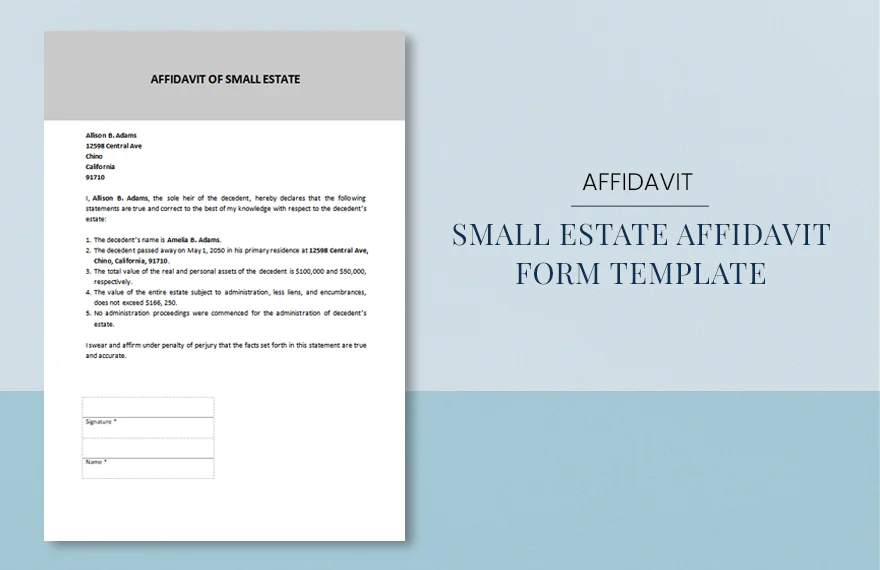
3. Sample Of Small Estate Affidavit Template
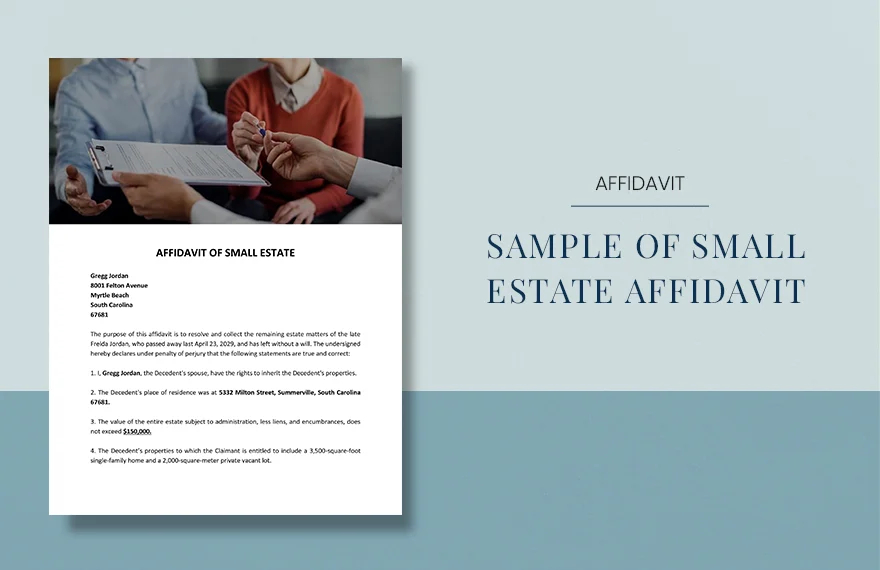
4. Sample of Small Estate Affidavit Template

5. Small Estate Affidavit for Nonresident
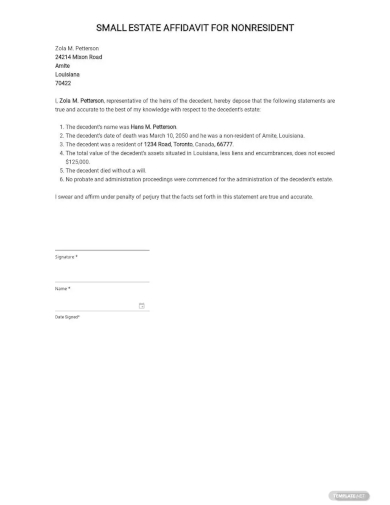
6. Small Estate Affidavit Form
What is a Small Estate Affidavit?
At its core, a Small Estate Affidavit (SEA) is a legal document that facilitates the process of property and asset transfer after someone’s death. It offers an alternative to the often complicated and prolonged probate process, providing a streamlined approach for heirs when the deceased’s estate is modest in size and doesn’t meet certain financial thresholds.
Understanding the nuances of this legal tool is essential for those who are considering it as an option. Here’s an in-depth look:
The Essence of a Small Estate Affidavit:
Upon the death of a loved one, the matter of distributing assets and settling debts becomes paramount. While most are familiar with the concept of probate, the legal procedure through which a deceased person’s assets are distributed, many may not realize that this can be a lengthy and potentially costly route, especially when estates are simple and small in value. That’s where the Small Estate Affidavit steps in.
Advantages of the SEA:
Bypassing Probate: The primary allure of the SEA is its ability to circumvent the traditional probate process, saving both time and money for the heirs.
Simplicity: Given that it’s designed for smaller estates, the document is relatively straightforward, focusing only on the essential details of assets and liabilities, and the rightful heirs.
Key Elements of the Small Estate Affidavit:
Deceased’s Personal Details: This covers the full name, last known address, and date of death.
Affiant’s Statement: The affiant the individual completing the affidavit must declare their relationship to the deceased, asserting their legal right to claim a portion or all of the estate.
Description of Assets: This includes a detailed account of the deceased’s assets. It could cover bank balances, stocks, bonds, personal property, and more. Importantly, it does not typically include real estate, unless specific conditions are met.
Debts and Liabilities: Before distribution, the estate’s debts must be acknowledged and settled. This section lists any known debts, including funeral expenses, medical bills, or other outstanding payments.
List of Heirs: This is a rundown of every individual entitled to a share of the estate, detailing their relationship to the deceased.
Sworn Statement: Here, the affiant officially attests to the accuracy of the information provided, often in the presence of a notary public.
Limitations and Considerations:
While the SEA offers multiple benefits, it’s vital to approach it with a clear understanding of its limitations. Each jurisdiction has specific criteria regarding the maximum value an estate can possess to qualify for an SEA. Furthermore, while it can cover personal property, most jurisdictions have stringent regulations about including real estate.
In sum, a Small Estate Affidavit is a powerful tool designed to simplify the often-complex realm of estate settlements. However, like all legal instruments, it demands careful consideration and, ideally, consultation with legal experts to ensure it’s the most suitable option for a given situation.
7. Sample Small Estate Affidavit
8. Small Estate Affidavit Template
9. Notarized Small Estate Affidavit
10. Small Estate Affidavit Document
11. Small Estate Affidavit in PDF
12. Affidavit of Small Estate
13. Small Estate Court Affidavit
When Should a Small Estate Affidavit Be Used?
The death of a loved one is a profoundly emotional experience, and the subsequent distribution of their assets can further amplify the stress. While probate serves as the standard route for estate settlements, it’s not always the most efficient or appropriate method, especially for smaller estates. Enter the Small Estate Affidavit (SEA) – a potentially quicker, simpler alternative. But when exactly is it appropriate to use this tool? Let’s delve into the circumstances and considerations surrounding its application.
Estate Size and Value:
The primary determinant for using an SEA is the size and value of the estate in question. Jurisdictions set a monetary threshold for estates eligible for this route, with the specifics varying across regions. If the total value of the deceased’s assets, minus any exempted assets like a family home, falls below this stipulated value, the estate qualifies for an SEA.
Types of Assets Involved:
A Small Estate Affidavit is particularly beneficial when the assets in the estate are relatively straightforward, like personal property, bank accounts, or small investments. Real estate properties, on the other hand, might introduce complexities. While some jurisdictions allow for real estate to be transferred via an SEA, they often come with strict stipulations and conditions.
Absence of a Formal Will:
In situations where the deceased did not leave a will, the estate is considered “intestate.” Instead of undergoing the more demanding intestate probate process, an SEA offers a streamlined alternative, provided the estate’s value is below the designated threshold.
Efficiency and Cost-Effectiveness:
The probate process can be time-consuming, sometimes stretching over months or even years. This duration can be a significant burden for heirs awaiting their inheritance or those burdened by associated costs. Given its more direct approach, an SEA often allows for a faster resolution. Additionally, because it avoids the more complex probate process, it often results in reduced legal and court fees.
Outstanding Debts and Liabilities:
An essential step before deploying an SEA is to gauge the estate’s outstanding obligations. The affiant – the individual filing the affidavit – assumes responsibility for ensuring that all the estate’s debts, such as medical bills, taxes, or unpaid loans, are settled before distributing assets to the heirs. If liabilities overshadow the assets, or if there’s uncertainty regarding outstanding debts, the traditional probate route might be more suitable since it provides a structured mechanism to handle creditors.
Potential Contests or Disputes:
If there’s any inkling of potential disputes among heirs or beneficiaries, it might be prudent to avoid an SEA. The streamlined nature of the SEA process doesn’t lend itself well to handling familial disputes or disagreements. A standard probate process, while lengthier, provides a more robust framework for resolving such conflicts.
Benefits of Small Estate Affidavit
The Small Estate Affidavit (SEA) stands as an alternative tool in the realm of estate management, offering a more streamlined process than the traditional probate procedure. Designed specifically for modest estates, the SEA carries a suite of benefits that can significantly ease the burden of asset distribution after the passing of a loved one. Let’s explore these advantages in detail:
1. Expedited Asset Distribution:
Perhaps the most prominent benefit of an SEA is its speed. Traditional probate can stretch out for months or even years, leaving beneficiaries in limbo. With an SEA, eligible assets can be transferred to the rightful heirs in a matter of weeks, depending on the jurisdiction. This swiftness can be especially crucial for beneficiaries who might be depending on these assets for financial stability.
2. Cost Savings:
Navigating the probate process often involves legal fees, court costs, appraisal fees, and other associated expenses. In contrast, the SEA process can significantly reduce these costs. By bypassing many of the steps and formalities of probate, heirs can potentially save thousands of dollars, ensuring that more of the estate’s value goes directly to them rather than administrative costs.
3. Simplicity and Accessibility:
For those unfamiliar with legal proceedings, the labyrinth of probate can be overwhelming. The SEA, with its straightforward approach, makes the process more accessible. Its standardized format outlines clear steps, from identifying assets to listing heirs, making it easier for laypeople to understand and complete.
4. Reduced Paperwork:
With the probate process comes a deluge of documents, filings, and forms. The SEA, on the other hand, consolidates much of this paperwork into a singular, comprehensive document. This reduction not only eases the administrative burden on the executor or heirs but also minimizes the risk of errors or oversights.
5. Flexibility in Absence of a Will:
If the deceased did not leave a will, the estate becomes “intestate,” and the distribution process can get even more complicated. In many jurisdictions, the SEA offers a pathway for heirs to claim their inheritance without wading through the challenges of intestate probate, as long as the estate value remains below the stipulated threshold.
6. Transparency and Open Communication:
Using an SEA often necessitates open communication among heirs. As they collaborate to complete the affidavit, potential misunderstandings or disputes can be addressed upfront, fostering transparency and reducing the risk of future conflicts.
7. Peace of Mind:
Beyond the tangible benefits, the SEA offers peace of mind to grieving families. By alleviating the complexities of probate, families can focus on healing and remembrance, knowing that the legal aspects of their loved one’s estate are being managed efficiently and with minimal fuss.
the Small Estate Affidavit emerges as a beacon for those navigating the choppy waters of estate settlements, offering a swifter, cost-effective, and user-friendly alternative. However, as with all legal tools, it’s crucial to ensure it aligns with the specific circumstances of the estate and to consult with professionals when in doubt. This ensures that the benefits of the SEA are fully realized while adhering to all legal obligations and standards.
14. Small Estate Affidavit Letter
15. Generic Small Estate Affidavit
16. Small Estate Real Property Affidavit
17. Small Estate Legal Affidavit
18. Small Estate Authority Affidavit
19. Personal Property Small Estate Affidavit
20. Editable Small Estate Affidavit
21. Affidavit for Small Estate Template
How to Get a Small Estate Affidavit?
A Small Estate Affidavit (SEA) serves as a relief for those navigating the daunting journey of estate settlements. By providing an alternative to the often cumbersome probate process, it offers beneficiaries a more efficient pathway to claim their inheritance. But how exactly does one obtain and file a Small Estate Affidavit? Let’s walk through the steps:
1. Determine Eligibility:
Before anything else, ascertain whether the estate qualifies for an SEA. Each jurisdiction sets a maximum value for estates eligible for this process. You’ll need to gather information on all of the deceased’s assets and liabilities to ensure the net value falls below this threshold. Additionally, check if the deceased’s estate includes real estate or other assets that might be excluded or come with specific stipulations for SEA eligibility.
2. Obtain the Appropriate Form:
Many jurisdictions have standardized SEA forms available. These can typically be sourced from:
The local county or probate court’s office or website.
Online legal service platforms.
Local law libraries.
Legal aid offices.
Ensure you get the correct form for your specific jurisdiction to avoid complications down the line.
3. Complete the Affidavit:
While filling out the SEA:
Provide accurate details about the deceased, such as their name, date of death, and last known address.
Detail all the deceased’s assets and liabilities. This should encompass bank accounts, personal property, investments, outstanding debts, and other obligations.
List all the known heirs and their relationship to the deceased. Specify the portion of the estate each heir is entitled to receive, usually based on state intestacy laws if there’s no will.
Make sure all information is accurate and complete. Providing false information can lead to legal penalties.
4. Notarization:
After completing the affidavit, you’ll typically need to sign it in front of a notary public. This step verifies your identity and confirms that you’re signing the document of your own free will.
5. File the Affidavit:
Once notarized, submit the SEA to the appropriate local authority, usually the county or probate court where the deceased resided. Some jurisdictions might require a waiting period after the death before you can file the affidavit, ensuring that no will surfaces in the interim.
6. Notify Creditors and Financial Institutions:
After filing, it’s essential to inform any creditors of the deceased, as well as banks or financial institutions holding the deceased’s assets, about the SEA. They will typically release the assets or address outstanding debts based on the information provided in the affidavit.
7. Distribute the Assets:
With the SEA in place and recognized by financial institutions, assets can now be distributed to heirs as outlined in the affidavit. Remember, all outstanding debts and obligations of the deceased should be settled before asset distribution.
8. Seek Legal Counsel:
While the SEA process is designed to be user-friendly, complexities can arise, especially in larger estates or those with potential disputes. It’s always wise to consult with a legal professional when navigating the process to ensure compliance with all regulations and laws.
In essence, obtaining and filing a Small Estate Affidavit is a sequence of deliberate steps aimed at ensuring the smooth transition of assets. By following the guidelines and always prioritizing accuracy and transparency, beneficiaries can bypass much of the red tape associated with traditional probate and more quickly receive their rightful inheritance.
Related Posts
Retirement Speech Samples & Templates
Weekly Schedule Samples & Templates
Contractual Agreement Samples & Templates
FREE 9+ Amazing Sample Church Bulletin Templates in PSD | PDF
Sample Business Card Templates
Sample Cashier Job Descriptions
Questionnaire Samples
FREE 10+ Sample HR Resource Templates in PDF
FREE 49+ Sample Job Descriptions in PDF | MS Word
FREE 23+ Sample Event Calendar Templates in PDF | MS Word | Google Docs | Apple Pages
Company Profile Samples
FREE 10+ Leadership Report Samples [ Development, Training, Camp ]
FREE 24+ Sample Payment Schedules in PDF | MS Word
FREE 10+ Return to Work Action Plan Samples in PDF | DOC
Autobiography Samples & Templates

